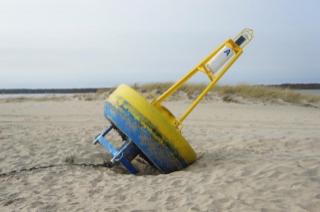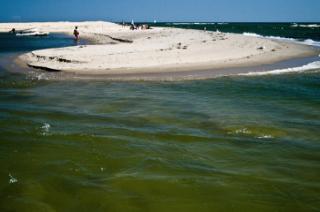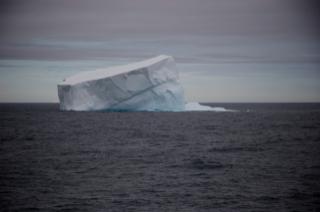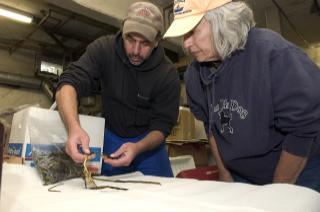
Woods Hole Oceanographic Institution
2011
A scientific buoy was among the flotsum that washed up on South Beach when the remnants of Hurricane Irene passed over the Island two weeks ago. Susan Snider found the Woods Hole Oceanographic Institution buoy on last Sunday and submitted the photograph to the Gazette.
Janet Fredericks, an operations manager for the institution, wrote and said it was a guard buoy, a marker used to alert and keep vessels away from the underwater scientific gear beneath. The institution maintains a sub-sea observatory along with a shoreside weather observatory.
This month scientists from the Woods Hole Oceanographic Institution will descend on Edgartown with a sonar-equipped waverunner to map, in unprecedented resolution, the ever-shifting sands and currents of Katama Bay. While the bathymetry of the body of water, where change is a constant feature, is of special scientific interest to the Woods Hole scientists, the information is even more valuable for the surprising underwriter of the project: the U.S. Department of Defense.
2010
Think Antarctica and you think snow. A vast and unending, featureless panorama of it.
Andrew McDonnell, a PhD student at the Woods Hole Oceanographic Institution and MIT, traveled to the Palmer U.S. Research Station in Antarctica to see snow, but not on land. Instead Mr. McDonnell was interested in the timeless undersea blizzard of particulate matter known as marine snow, the ghostly detritus of animals that descends the water column, sometimes taking months to reach the bottom.
2009
It sounds like a bad science fiction movie: a slime from outer space has reached the earth. It spreads underwater across the harbors and bays of a small Island community and eventually throughout the East Coast. The world’s top scientists gather to study and discuss the problem..
What it sounds like is nearly true in the waters along the eastern seaboard, only in this case the slime is believed to come from the Sea of Japan.
1956
“Cap’n” Seth Wakeman Jr. of Menemsha reports that representatives of the Oceanographic Institution at Woods Hole got “some of the best whale pictures ever taken,” during a recent visit to the Island. In addition to taking still and movie shots, the scientists also had excellent luck in recording the sounds of the whales which have been seen off Menemsha Bight and Gay Head in recent weeks.






